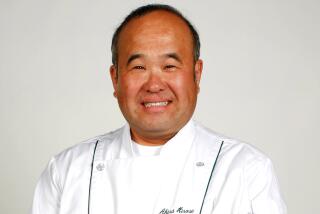Arita Wares--No Pale Imitation
- Share via
The Japanese have a reputation--not altogether justified--for plagiarism. In past centuries, they were particularly open to the charge of having copied the Chinese. Their calligraphy, their brand of Buddhism and their bronzes all owed much to Chinese example. It was understandable that a small land should imitate a big land.
But in one respect, the Japanese stayed relatively independent of the Chinese--in the making of pottery and porcelain. That is perhaps surprising, because no one could deny that the Chinese made the finest ceramics in the history of the world. In the Middle Ages, European emperors quite rightly kept Chinese porcelains in their treasuries, alongside vessels of gold and silver. Copernicus and Galileo had shown that the earth revolved around the sun; now the Chinese potters would cause the sun to shine through the earth.
The distinguishing characteristic of Chinese ceramics was a fearful symmetry. The Japanese had a quite different idea. From the very earliest Jomon pots, in which fragments of shell and stone were incorporated, they went for beguiling imperfection and asymmetry. Sometimes, as a last refinement, or rather de -refinement of that style, they made cracks in perfectly potted bowls and filled the cracks with gold lacquer.
I know a connoisseur of Chinese porcelain who deprecates the Japanese attitude and the Japanese wares. “I like my pots round, “ he says, in stout defense of Chinese symmetry. But the champions of the little, misshapen Japanese tea-bowls--with their accidentally-on-purpose dribbles of thick glaze and their spattering of pockmarks, speckles and freckles--find something philosophical in that appreciation of the blemished, the not-quite-immaculate. Mankind too, they suggest, is imperfect; why, then, should his artifacts be inhumanly perfect? Let him that is without sin throw the first pot, they seem to imply. The Latin poet Horace put it nicely (as we expect of Horace). “Amphora coepit Institui, currente rota, cur urceus exit? “ (Loose translation: “A stately vase was planned; why, then, does this misshapen pot come from the revolving wheel?”)
The best-known name associated with Japanese ceramics is Arita. Arita is a place, and in that place, many potters have flourished. To be precise, it is in the province of Hizen, northwest of the southernmost island of Japan, Kyushu. The 18th-Century wares were distinguished by an un-Chinese freedom and spontaneity of design and influenced such European factories as Meissen in Germany and Bow in England.
Today the Arita area is still rich in potteries, and Sept. 11-13, the Greater Arita Ceramic Assn. will be showing examples of its wares at the Design Center of Los Angeles, 433 S. Spring St. (Hours: Wednesday and Friday, 10 a.m. to 4 p.m.; Thursday, 10 a.m. to 6 p.m.)
Some of the modern Arita products are traditional. Yamato Tojiki, one of the best known firms, decorates cups with flowers on a royal-blue or apple-green background faintly reminiscent of Chinese famille rose and famille verte porcelains, or even of the Sevres china with plain-color backgrounds. Its plain white wares with designs cut into the paste have antecedents in China. But the firm also manufactures teapots with segments in brilliant colors; cuff links with an Art Deco touch; knife rests resembling miniature ships, and bottle openers with porcelain handles. Its mind-boggling pierced wares owe an evident debt to Japanese ivory carving but are to be judged as feats of virtuosity, conversation pieces and centerpieces rather than as works of art. They are the Paganini violin concertos of ceramics.
The Gen-Emon kiln, nestled in the mountains of Arita, produces a dazzling version of the traditional “quail” pattern, in a mosaic of blue tesserae. That design may be too busy for those who prefer tea bowls and saucers exquisitely decorated with blue sprays of leaves, with a border of eau-de-nil . Gen-Emon also makes umbrella handles, earrings, handbag clasps and even a porcelain pipe. The pipe appears almost too frail for burning tobacco, but it has undergone far fiercer temperatures in the kiln. I can’t help feeling, though, that it would look affected for a man, and only the most militantly liberated women smoke pipes, even today.
Sanryu-do Co. Ltd. makes beautiful, lotus-shaped bowls and leaf-molded trays. Natural vegetation is the model for many of its wares, which show Japanese asymmetry in all its delightful waywardness and wantonness.
Marubun Shinohara Co. Ltd. makes some attractive oven wares in gradated brown shades, but also a casserole with a hideous devil mask as a cover--a devil with bulging eyes and snaggle teeth. One of their tea bowls is painted with a wave that’s about to peak and spill over, like the “Great Wave” of Hokusai’s woodblock print.
Yamachu Co. Ltd. specializes in a finely potted nest of dishes, fitted snugly around a flower vase. They can be used for sushi or for Western hors d’oeuvres.
Blue is the predominant color of the wares made by the Togen Co. Ltd., with reserves of plain white, as eloquent as an actor’s “dramatic pause.” Where to leave off decorating is part of the problem for any ceramic artist; primitive wares often suffer from the horror vacui --the superstitious dread of the empty space. The Togen teacups, which have handles (a merciful Western invention, maybe detracting from the aesthetic effect but easier on sensitive fingers), are the most fancifully decorated of any firm’s. One could give a friend one of these elegant teacups and say it is a Togen of one’s appreciation.
Samples of Japanese porcelain include these dishes (above), for entertaining, by Sanryu-do, an 18-inch plate (right) in underglaze blue and overglaze enamels by Gen-Emon and, also by Gen-Emon, a jar (below) with a design of clematis in underglaze blue and overglaze enamels.
More to Read
Inside the business of entertainment
The Wide Shot brings you news, analysis and insights on everything from streaming wars to production — and what it all means for the future.
You may occasionally receive promotional content from the Los Angeles Times.









